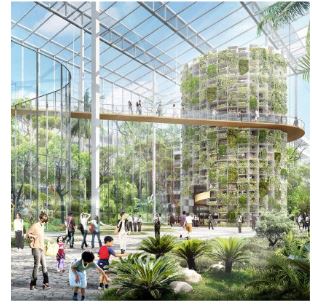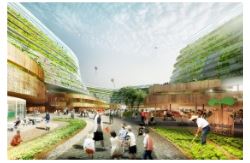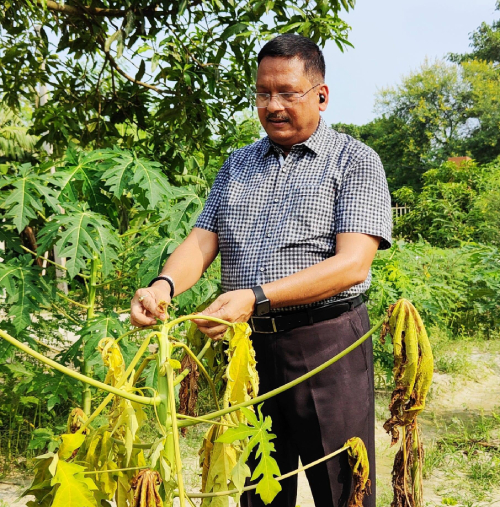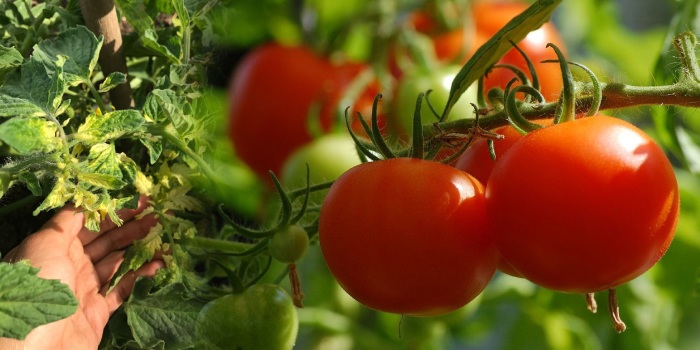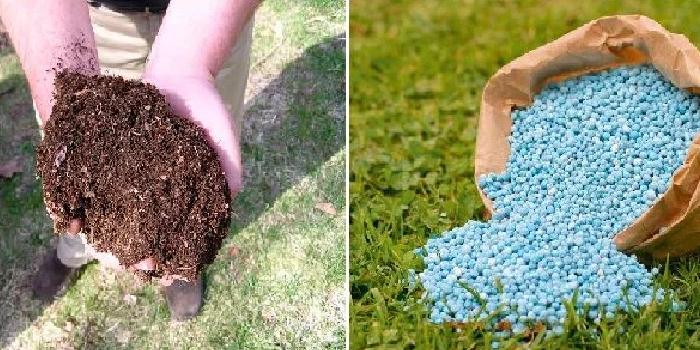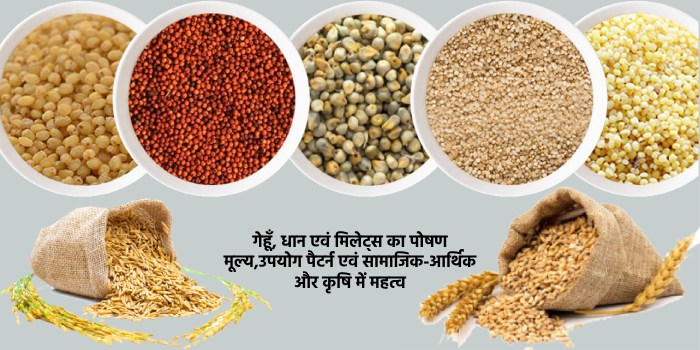Samuel Shay July 2021
IntroductionIt is predicted that by 2050 the global population will reach approximately 9.8 billion people, of which 70 percent will reside in urban centers, which will result of higher demand for food and water to the expense of 70 percent more than today. The growing demand for water for agricultural needs is already putting pressure on the current food systems, as many countries are facing water crisis due to climate changes (i.e., global warming, droughts) which has yet been resolved by technological means to overcome the water stress, such as seawater desalination, rain harvesting techniques or wastewater purification for irrigation needs.
Despite much progress has been made of efficient utilization of water for agricultural needs, agriculture still is one of the world’s main users of freshwater. Irrigated agriculture is responsible for approximately 70 percent of all the freshwater withdrawal in the world, and more water will be used for irrigation in the future to meet world food demand. By 2025, 1.8 billion people are expected to be living in countries or regions with less than 500 cubic-meters of annual water supply per capita (absolute water scarcity), and two-thirds of the world population would be under “stress” conditions defined as “water scarcity” (between 500 and 1000 cubic-meters per year per capita).
Climate changes also cause a destruction of the soil due to prolonged periods of droughts, and as a result reduce the availability of land for agriculture. Moreover, the constant need for land and water in the industry and urban sector due to population growth reduces their already low availability for agricultural needs. At present, over 800 million hectares, or about 38 percent of the world’s landmass, are used for agriculture. Under current conventional agriculture practices an estimated 10 9 hectares of new land will be needed to grow enough food to feed the whole world’s population by 2050.
Therefore, land, water (and energy) will have to increase in order to cope with the growing demand for food production and supply. This requires immediate actions in order to minimize as much as possible the dependence of agriculture on the above resources and their impacts on food security.
Food security is: “A situation that exists when all people, at all times, have physical, social and economic access to sufficient, safe and nutritious food that meets their dietary needs and food preferences for an active and healthy life. Based on this definition, four food security dimensions can be identified: food availability, economic and physical access to food, food utilization, and stability over time”.
More than 2 billion people suffer from food insecurity, expressed as a consumption of insufficient quantity and/or quality and nutritious food (a deficit in vitamins and minerals such as iron, zinc and vitamin A) required to maintain an active and healthy life. This originates from faults along the food system limit its availability, the access to it, its utilization and stability over time. People may experience moderate to severe hunger, sometimes stay for several days without food. This phenomenon is globally wide, both in low- and high-income countries, but more common in regions of Sub-Saharan Africa (SSA), Southern Asia, Latin America and the Caribbeans, where poverty, poor infrastructure and technology are the main causes to severe food insecurity among smallholder and rural communities. Part of that is because lower-income communities lack of access to healthy fresh food which usually is less available in food stores in their vicinity, leaving them no other choice but purchasing the higher prevalence energy-dense foods which often costs more in these stores compared to large supermarkets. This has been shown to lead to unhealthy diets and increased levels of obesity for people living in these areas.
The situation in the cities is no better. In urban settings lack of income is translated more directly into lack of food than in rural settings. The rapid urbanization in developing countries and SSA in particular, goes together with a rapid increase in urban poverty and urban food insecurity, and it will worsen if preventive measures are not taken. As a large share of the poor household income goes to food (between 54 and 76 percent in SSA capital cities), any spikes in food prices will push tens of millions more into extreme poverty and to severe food insecurity. Food production in the city, i.e., urban agriculture (UA), is in many cases a response of the urban poor to inadequate, unreliable and irregular access to food by rural agriculture (RA), the primary producer of food in cities.
UA and peri-urban agriculture can be defined as the growing, processing and distribution of food crops and other products (seldom raising livestock) through plant cultivation within and around the city. The idea behind UA is that each city will produce its own food for self-consumption, without the need to be dependent on external forces that may interfere with the supply of food, such as poor transport or natural hazards. The lack of free areas for agriculture needs within the city can be partly solved, for instance by utilization of abandoned areas or old buildings.
UA can contribute to food security in each of its four dimensions. The proximity of the consumer to the product shortens the food supply chain, increasing by that the availability and accessibility of fresh and healthy produce in food insecure areas in cities, for individual families, community groups, and urban markets. Moreover, the availability of locally produced foods in cities can possibly encourage the consumption of fruit and vegetables by typical consumers and may help to reduce consumption of less healthy processed foods. Shifting some food production to areas of high demand can reduce energy use and environmental impacts of the food industry associated with food supply chains, for example cutting transportation-related greenhouse gas emissions (the current food system is responsible for up to 30 percent of the world’s greenhouse gas emissions), which itself contributes to food production since the global rise of atmospheric CO 2 concentration also affects crop yield as plants response differently to these changes. Lowering transport time and distance can also minimize food spoilage (especially perishable foods), caused by poor storage or transport conditions which may occur along the food supply chain.
The ability to acquire food is determined mainly by its cost, which is affected by value-chain processes such as storage and transport. It is estimated that 13.8 percent of the produced food (worth more that USD 400 billion) is lost every year during its processing, transport and storage. Shifting these processes to minimum through UA by direct supply of the products from the farm to the consumer, is expected to reduce the prices of food, thus providing millions of poor people around the world a better access to food, especially in low-income countries where food insecurity is the highest due to poor production combined with poor storage and transport that cause a high rate of food loss and high prices of food as a result which are above the household’s purchasing power.
The degree of food security is also determined by actions taken from the consumer side to minimize food waste as a result of over consumption or over purchasing of food which eventually can get spoiled before consumed and thrown away. Synchronizing between the urban farmer as the supplier side and the consumer needs will help to reduce food waste by growing just the amount of food that will suffice the local market demands for self- consumption.
All of these actions can potentially lead to the creation of resilient cities which are dependent on their own in food production and supply for self-consumption, without any interference from external forces that may affect food safety such as environmental or economic crises. Thus, countries should encourage urban and peri urban agriculture, also because it will upgrade employment and income generating opportunities for the urban poor and improve the supply of local markets with fresh and nutrient-rich foods at competitive prices. However, it is difficult to quantify just how much UA contributes to the global food supply (according to UN Food and Agriculture Organization, UA provides 15 – 20 percent of the world’s food), since it can vary extensively among cities based on each one’s resources. For example, some cities don’t have enough urban area to satisfy the consumption demands of their citizens while other need less than 10 percent of their urban area to do so. On average, UA would require 30 percent of the area of cities globally to provide for the total vegetable consumption of urban dwellers. For cities that lack available urban space, an option could be the use of rooftop gardens, vertical farming, and indoor growing methods, which could still answer the need for large amounts of land area for urban growing.
At present, UA is widespread around the world with more than 800 million people practice it, including the developing countries with over 20 million people in West Africa, where it has been shown to have a positive impact on food security. Many cities across the world have reported high degrees of food self-sufficiency by UA. For example, in Shanghai, China, UA is able to supply 50 percent of its vegetable demands; in Dar-es-Salaam, Tanzania UA produces 90 percent of leafy vegetables and 60 percent of milk consumed.
Many different types of UA exist. Activities range from personal scale in privately owned areas (household gardening), community and public scale (community gardens, vacant lots, parking lots, parks, institutional gardens for example in schools, prisons, churches, community centers or hospitals, rooftop gardens and public food forests) growing food for self-consumption, to commercial scale (for-profit or non-profit urban farms, indoor farms and vertical farms), with farm products are directly supplied to the consumer, distributed through community supported programs or through retailers. The consumer can range from private household to specific business (in a restaurant, as part of a gas station for growing bio-fuel crops, in a ketchup factory for growing tomatoes etc.) to the whole public. In addition, in cases where a farm replaces asphalt or some other hardscape, the urban heat island is reduced. Of the activities above, those executed in open space are categorized under Uncontrolled Environment Agriculture (UEA) or open space agriculture. Controlled Environment Agriculture (CEA) includes any form of agriculture where environmental conditions (such as, light, temperature, humidity and radiation) are controlled in conjunction with urban structure or infrastructure. Among the methods of CEA are greenhouses and vertical farming.
To conclude, UA has the potential to contribute to local food security by increasing the availability of and access to fresh and healthy produce. In the future, the ability of cities to produce at least a portion of their own food supply will become important as climate change- driven natural disasters are expected to increase in frequency and severity, thus affecting the global supply chain. Multi-disciplinary research and governmental support are needed for UA to be used effectively as a tool to support the 2nd UN Sustainable Development Goal (SDG 2) to end hunger in all its forms by 2030.
Vertical farming
Vertical farming (VF) is an example of commercial UA in which fruits, vegetables and grains are stacked in layers that may reach several stories tall for instance inside warehouse, buildings or any other urban structure. Its growing method – indoor under full controlled climate and agronomical conditions (precise light, nutrients and temperatures) – seems the most efficient method to provide food security. By almost completely excluding natural interferences (e.g., soil, sunlight, rainfall) from agriculture, high crop yield can be produced all year round, increasing by that the farmer profitability. The use of detached growth substrates (for example coco coir peat or water channel in hydroponic application), combined with big data analytics, internet of things and artificial intelligence for on-line monitoring and operation to provide optimized number of resources the plant requires (i.e., precision agriculture), creates an optimal condition for various types of plants and provides the highest crop productivity, no matter what the climate or environmental conditions are. This, in turn, reduces the need for fertilizers, herbicides, and pesticides. A variety of crops can be grown, including ornamentals, pharmaceuticals, nutritional supplements, flavors, etc.
Although VF can help achieve the three pillars of sustainability (i.e., environmental, economic, and social), it is not enough to solve the global food insecurity or even provide sufficient food supply in city scale, in light of the rapid urbanization, especially not replacing land consumers crops such as cereals (wheat, maize, cassava, sorghum and rice, root vegetables like potato) to produce staple foods. But it could evolve in parallel to the conventional agriculture, in particular growing and supplying fresh fruits and vegetables for city dwellers, beyond its contribution to water and land resources.
Since VF requires a massive capital for the construction of a new building or installation of advanced infrastructure on existing structure, performing a preliminary market survey is essential before any further decisions are taken. This includes identifying the potential customers in terms of type (household, commercial business), income (purchasing power), location (distance from distribution center), food preferences (e.g., organic or other food when deciding which type of crops to be grown) etc.
Structure types
VF systems can be placed in almost any urban structure. Generally, they can be divided into two categories of growing structures: horizontal system with multiple levels of growing platforms in one space or growing in high-rise building, and growing in a vertical surface, for example inside cylindrical units attached to wall. High rise building can be new or old, for residential or commercial uses, in which few floors are using to grow food for the locals, the workers’ cafeteria and even growing lettuce (and other green leaves) destined to feed the zoo animals. Utilization of abandoned warehouse for VF or new farm built on environmentally damaged lands, raising by that the value of these marginal parts of the city.
Other structure in use is used modular shipping containers ocean transports that can be located in places such as parking lots or vacant lots, after being refurbished into self-contained vertical farms, complete with LED lights, drip-irrigation systems, and vertically stacked shelves for growing plants. These units are equipped with computer-controlled growth management systems that allow users to monitor plant growth remotely from a smart phone or computer. An example of VF shipping containers is Crop Box (a product of “Vertical Crop Consultants”, North Carolina, USA). Crop Box is equipped with hydroponic growing system and software monitoring system to control environmental conditions inside the container – temperature, lighting, water, pH, CO 2 and humiditylevels. Lighting is provided by high-end fluorescent lights while a 200- gallon (757 liter) reservoir and pump system allows water to circulate. Manufacturers say the Crop Box uses 90 percent less water and 80 percent less fertilizer than conventional farms, as well as requiring no pesticides. Another leading manufacturer of VF units based on a platform of shipping container is “Freight Farms” from Boston, USA. Marketed under the name “Greenery S”, the unit uses precision growing technology that can be managed through the smartphone, and according to the company is capable of growing lettuce, leafy vegetables, herbs, brassicas, certain root vegetables, edible flowers and many other crops. Also, to date, over 300 different crop varieties have been examined in this system. The Australian “Modular Farms” unit, according to the manufacturer, is able to increase growing capacity by up to 125 percent and use less than 40-liter water a day by capturing up to 190 liters of the water vapors released by the plants via dehumidification process. One last example comes from “Cubic farms” company, Langley, British Columbia. Their system is fully automated and environmentally controlled (temperature, lighting, CO 2 and humidity) through the smartphone. It uses specialized growing trays that are rotated in a “V-shape” motion every 90 minutes to ensure all sides of the plant receive the optimal amount of light to maximize their growth and allows for an easy harvest as it provides an access to the plants at the front.
VF growing systems.
VF uses one of three soil-free systems for providing nutrients to plants: hydroponic, aeroponic, or aquaponic. The following information describes these three growing systems:
1. Hydroponics. The predominant growing system used in VF. Plants are usually grown in cylinder-shaped system, placed inside a medium filled with either sand, gravel, perlite, expanded clay, vermiculite, rockwool (the most used medium) etc, or float in nutrient-rich solution medium (also known as Nutrient Film Technique – NFT) as a substitute for soil. The solution can either be recycled in a closed system or used once in an open system and is frequently monitored to ensure that the correct chemical composition is maintained. In a closed system the growing tray is filled with the nutrients solution few times a day, set by a timer based on parameters such as growing stage, water and nutrient level etc. Excess water from the tray is drained back to a reservoir below to be used again in the next cycle. Hydroponic system also needs to be well-ventilated. Hydroponic is used for both commercial and domestic food production as a hobby. It is recognized as a viable method of growing vegetables (e.g., tomato, lettuce, cucumber and pepper) as well as ornamental crops such as herbs, roses, freesia and foliage plants.
2. Aeroponics – NASA is responsible for developing this technique. Plants are grown in an air with no soil or aggregate medium. The seeds are inserted into tiny pots filled with pieces of foam, which are exposed to light (often LED lighting) and sprayed with nutrient rich water solution. The foam holds the stem and root mass in place as the plant grows. An aeroponic system is by far the most efficient plant-growing system for vertical farms, using up to 90 percent less water than even the most efficient hydroponic systems. And since the nutrients are dissolved in the water, they also get recycled. Plants grown in these systems have also been shown to uptake more minerals and vitamins, making the plants healthier and potentially more nutritious.One of the world’s leading companies in aeroponics VF is Aero farms. It operates in New Jersey one of the largest commercial vertical farm in the world, with 6,500 square-meters and 9 meters high. It is estimated to produce 900 tons of greens per year and have annual yields 390 times higher per land area compared to traditional farming. This company has eight other smaller facilities and plans to build another large 7000 square-meters facility in New Jersey. Company claims their annual production is 75 times more than the field per unit land area, and even 10 times more productive than a hydroponic greenhouse. Also, they use over 95 percent less water than growing out in the field, to grow a seed that would take 30 to 45 days to grow out in the field, with just in 12 to 16 days. The company has grown over 550 different varieties of plants including leafy greens, berries, tomatoes, and more. Focus is made on growing leafy greens in order to maximize the number of trays that can be stacked up inside the vertical farm, as plants like tomatoes and peppers, for example, grow too tall to be efficiently stacked.
3. Aquaponics – Plants and fish are grown in an integrated re circulating closed system. Freshwater fish are grown in indoor tanks or ponds, producing nutrient-rich waste to be used as a feed source for the plants. The plants, in turn, filter and purify the ammonia-rich wastewater, which is recycled back to the fishponds. The most popular fish are tilapia and barramundi because they grow fast and tolerate better changes in water conditions. Trout can also be used, especially for lower water temperatures. The system inputs are fish food and energy for the water pumps and water heaters, but once it is established, only pH and ammonia levels have to be monitored. Wastewater can also be used as a food source for the fish. Currently, aquaponics is used in small-scale VF systems. Most commercial VF systems focus on producing only a few fast-growing vegetable crops and don’t include an aquaponics component.
Technologies in use
Typical indoor features related to VF include:
1. Lighting techniques, such as HPS (high-pressure sodium) or LED (more common) that can be adjusted in spectrum and intensity according to the plant development, to achieve optimal photosynthesis for different types of crops.
2. Heating, ventilation, air conditioning (HVAC) and humidity control at specific levels that optimize the rate of plant growth.
3. Solar panels for lighting and heating.
4. Recycled water systems enhanced with rainwater or desalinated water. Any nutrients and water not absorbed by the roots can be recycled in the system.
Benefits
There are a number of economic, environmental, social, and political advantages of VF, related to UA in general, and specifically to VF due to its small land requirement that allow to place it near consumers (i.e., in and near cities) and the use of the most recent cost-effective and resources-saving technologies for plants growing and cultivating.
Economic
In a broad scale, economic benefits of growing food in indoor vertical farm include enhanced productivity with minimum requirements of resources and inputs compared to conventional agriculture (land, energy, water, nutrients, fertilizer, herbicides and pesticides and other inputs). Because of the fully controlled environment that ensures an optimal growth for each plant throughout the year, the production is free of extreme-weather related stresses that can cause annual yield variability and significant quality and yield losses. Growing next to the consumers (ideal location is near major retail outlets) reduces costs associated with processes or failures along the food supply chains such as transportation (including packing the crop/food designated for transportation) and storage costs or food loss because of poor storage.
Environment and health
Growing food in an indoor environment allows provision of healthy and affordable food, while minimizing environmental impacts such as reduced greenhouse gas emissions and energy uses, reduced impacts on soils and minimized air and water pollution. Energy saving – implementing VF on a large scale could result in a significant reduction in energy consumption, greenhouse gas emissions and air pollution in response to the short distance and transportation time from the food produced in the farm to the consumer as they are both located in the same vicinity, and because of other processes associated with the food supply chain that are reduced, for example cold storage. In addition, heavy field machinery such as tractors, trucks, and harvesters used in open field, are unnecessary in indoor agriculture, enhancing by that the workers’ protection against injuries from using this machinery. On the other hand, large amounts of electricity are needed to provide light, to pump the water in an enclosed system of nutrients solution recycling, and to heat or cool the plants; although new energy efficient LEDs are being developed that could reduce lighting costs.
VF can also be integrated with renewable energy, such as solar panels located on the roof of the growing facility or biogas generated in the production of methane in a digestion process of municipal organic waste or the bio-waste produced in the farm itself (e.g., leaves, stems, damaged crops), reducing by that both food waste and energy costs. The by-products of burning methane – CO 2 , heat and water – can be added to the farm atmosphere to aid with the plant's growth. The energy generated by solar panels depends on the building’s dimensions, and they are more effective in regions with an abundance of sunlight. When a building occupies a larger area, the lighting and water requirements increase, but so does the amount of energy available (via solar panels on the roof and facade). It is estimated that the amount of lighting needed indoors for plant cultivation is around 18 h per day.
Land use – The capacity to grow crops vertically is critical in urban environment where the competition over available land for industry, commercial, residence and other uses is high, leading to a rise in the land value. As a result, the availability of affordable land for urban farming decreases, leading farmers to search for low-cost or free land to farm. Under conventional crop production systems in the field (e.g., row crops) or in greenhouses, crops are grown in a single layer to ensure adequate sunlight and reduce resource competition over the crop canopy as well as in the root zones. Converting forest lands or wetlands is undesirable because it leads to deforestation, soil erosion, increased prevalence of resistant soil-borne pathogens, pests, and weeds, increased greenhouse gas emission, and ultimately the losses of other essential ecosystem services. Much of this can be attributed to the widespread utilization of unsustainable, intensive farming practices, such as the farming of high-yielding crops in monocultures and the use of excessive inputs of synthetic fertilizers and pesticides.
Thus, traditional farming in urban settings is not economically and environmentally feasible. VF can overcome these limitations by allowing the production of more food per land area (up to 30 times more than traditional agriculture, which means 30 times reduction in land use) or water while reducing pressure on current agricultural land. By doing that, forests can re-grow and play again a significant role in carbon sequestration and may help reverse current trends in global climate change.
Since urban land is an expensive commodity, most vertical farms would be located in less- expensive unused urban areas such as deserted industrial structures and vacant lots, raising by that their economic value.
Water use – Unlike outdoor environment where major part of the irrigation water is lost due to evaporation, water usage indoor has greater efficiency, which reduces the allotment of freshwater for irrigation. VF is claimed to have up to 350 percent greater water efficiency and uses as low as 30 and even 5 percent of the water in hydroponics and aeroponics, respectively, as compared to traditional agriculture. The amount of water needed for hydroponic is estimated to be 10.7 liter per each square-meter. This leads to an amount of 200 – 600 liters of water needed to provide 1 kilogram of dry product, depending on the crop type.
Water-saving can also be enhanced through the recycling of urban wastewater (i.e., gray water), which can be purified and converted to drinkable water through evapotranspiration. According to one estimate, it is able to collect 220,000 cubic meters of water every year using this method. Similarly, higher nutrient-use efficiency that can be achieved in a controlled and circular system which minimizes nutrient loss and reduces the contamination of water resources from excess nutrients (e.g., eutrophication). Given this, VF has an extra importance of its implementation particularly in hot and dry regions where water scarcity is high. Water savings has also political benefit in the reduction of water conflicts and downstream water pollution, especially in areas with cross-border water resources.
By cooling the air and capturing the condensed water, most of the water can be recovered. However, the costs of cooling air to recover the water can be significantly higher than the costs of using external water. Thus, water recovery is not cost-effective in areas with low water prices.
Elimination of Pesticides and herbicides – The controlled growing conditions allow reducing to minimum the use of chemical pesticides to complete avoidance of these substances, with the exception of use ladybugs and other biological controls to deal with any infestations. From marketing view, avoiding chemical pesticide matches also the & quot;ecological trend" of producing the healthiest food, in case the farm is addressing for a niche market. Excluding hazardous pesticides and herbicides protects farm workers and consumers from possible health effects that are associated with exposure to these chemicals and keeps them out of the water supply. In addition, it brings economic saving of agricultural inputs.
Food security
Food security constitutes issues of food quantity, quality, availability and constant access to food supply. VF can answer these four issues. The unique indoor growing conditions in a controlled environment that can be adjusted to each plant type, shorten the plant’s growing cycle and enable getting maximum crop yield per unit land area, leading to increased profits for the farmer. Moreover, using indoor light with the specific spectrum required has the potential to increase even more crop productivity, since the growing in not limited to sunlight hours. Growing under these conditions allows constant supply of food in any time all-year-round without being worried of natural hazards and weather impacts, and at the end point should bring to a fixed price of the food in any season of the year.
It is estimated that a single area of vertical farm may produce yield equivalent to as many as 4 to more than 30 times (for strawberries) the farmland area, depending on crop type. Bowery VF is claimed to have 100 times more yield than traditional farming. As an example, “Sky Greens”, a leading vertical farm in Singapore (9 meters-tall, hydraulic water-driven with A-shaped structures, containing 38 tiers of growing troughs based on soil or hydroponic processes, which are vertically rotated throughout the day in a way that plants at the bottom constantly receive water while the ones at the top receive sunlight) claims it can produce 10 times more yield per unit land area than traditional farming: up to 30 kg of vegetables a day, or 6 to 7 kg per each square-meter a month, in comparison to 2 to 3 kg produced in traditional farming. In Israel it is reported that one acre (about 4000 square-meters) of open field and VF could provide food for 12.5 and 97 people per day, respectively. Other estimate claims a container with an area of 30 square-meters could provide a yield equivalent to 1000 square-meters in the open field. In addition, it is estimated that one vertical farm in New York city, covers one square city block and rising up to 30 stories (approximately 900,000 square-meters), would be able to provide enough nutrition (2,000 calories/day/person) for 10,000 people. Similarly, a vertical farm in South Korea stands at three-stories estimates a building with 27 floors could provide food to 15,000 residents.
The most common crops produced in VF are tomatoes, leafy greens (lettuce, basil, Chinese cabbage, kale, spinach), herbs, eggplant, green onion/chives, strawberries and cucumber. Besides plant crops, VF can accommodate small animals such as pigs and poultry that needs the least space but produces the largest amount of meat. Large animals like cattle, sheep and goats seem to be exempted from VF.
The shortening of the food supply chain helps keeping the food fresh, healthy and available to city dwellers without the need to transport it over a long distance from the rural farms to city markets. This would also greatly reduce food spoilage since crops would be sold and consumed within short time after harvesting. In addition, consumption of healthy food could also help address chronic diseases (e.g., diabetes, obesity, heart disease), especially in “food desert” regions where there is high prevalence of continual hunger and malnutrition.
Under the right conditions, reduced agricultural inputs as well as other costs of transportation, storage, food loss etc, aside with high crop yields, in the end are expected to reduce food prices to become affordable to all city dwellers disregard of their socio-economic status.
SocialSocial benefits include provision of employment and social interactions, community building and personal welfare. More specifically, VF provides new employment and training opportunities in sectors of engineering, biotechnology, construction, and research and development. The location of vertical farm within or near urban gives an access to a large labor market and can boost creation of jobs in the above sectors, and also attracts the creation of indirect jobs like grocery stores, food markets and local distribution centers. While this may have an effect the economic stability of the less skilled workers occupied in traditional agriculture, with the proper governmental support (e.g., vocational training), reinforced by a pervious rich agronomical experience and knowledge, some of them would be more easily re-integrate in VF.
Another benefit is the protection or workers against injuries from using heavy field machinery, since it is not required in indoor farming. Besides, using empty/abandoned buildings, vacant lots and warehouses for production, can promote the development of whole surroundings.
Limitations and challengesFor the best outcomes of VM, it is important to consider its benefits aside with the limitations and potentials. The main barriers to the establishment of VF are high start-up and operation cost, especially in low-income countries, and limited amount and variety of crops can be grown, compared to large-scale conventional agriculture.
Start-up costs
Probably the most- and Least-expensive options for VF construction are farms installed from scratch in a new structure or integrated in existing structure such as designating several floors of high-rise building to vertical farms, respectively. In addition, as previously mentioned, since some urban locations can be quite expensive, some vertical farms are based in abandoned warehouses and deserted sites, which can be more economical for construction. Integrating the farm in existing building can lower more initial construction costs in comparing to traditional farming in the open field or in a greenhouse, since electricity and water infrastructure are already implemented in-house. Similarly, when apply precision agriculture, the local network or even wireless detectors in the building itself can use to transmit real-time data from the plant’s sensors to the mobile device and vice versa, in contrast to distance areas where communication network is sometimes out of range, so online monitoring is not possible. Also, it may be more cost-effective to apply VF in one or more lower story or smaller space buildings, instead of a single high-rise building.
Operation costs
High operation costs are derived mainly from high electricity usage to run indoor lighting and heating/cooling (and water to a lesser degree). Lighting is the most intensive input in VF. Highly efficient LEDs are used to mimic photosynthesis processes of natural sunlight. Using only the red and blue light wave lengths, which are optimal for plant growth (for example only red light is used for lettuce), helps reduce electricity costs by as much as 15 percent. LEDs may have a longer life – a lifespan of three years – but this also means they should be replaced in every three years. In addition, disruption of temperatures regime because of heat produced by the intensive lighting, would involve larger energy input for air conditioning, especially in summer. In the opposite direction, plant’s evapotranspiration releases the water absorbed to the air and brings down the surrounding temperature.
One way to diminish energy cost is designing the farm structure in such that absorbs as much natural light as possible, for example by using light shelves, tall as the height of the floor to let most of the light in. Another option is setting the structure shape at the right angle to get the maximum sunlight exposure, for example, like the A-shaped structure of “Sky Greens” farm with its unique rotating mechanism that allows regular exposure of the rotated plants tiers to sunlight during the day.
But even that, the total cost can be substantial. For example, apply VF in a 37-story building for 30 years is estimated at a cost of USD 248 million. And as VF is technology-intensive, this means it is extremely dependent on technology and energy for lighting, water re-circulating and maintaining temperature and humidity. So, power outage can cause significant losses to the business.
Other costs are related to the intense use of seeds. As mentioned, VF produces high crop yield than traditional farming. This also results from a short growing cycle of the plant. Thus, instead of harvesting once or twice a year as in traditional agriculture, in VF harvesting is done multiple times a year, so seeding is done more frequently.
New innovations and technology in the future will likely increase energy efficiency, for example by increasing the share of high efficiency photo-voltaic solar panels in the farm’s energy resources. At present, the authorities could facilitate the adoption of VF by strong decrease in electricity prices as well as other inputs such as water and property tax.
Limited plant types
At present, not all plants are suitable for VF due to long growing cycle, small-volume production, the height of the plants, pollination or other issues. Commercial VF usually focuses on high- return and rapid-growing plants such as lettuce, basil, and other salad greens. Slower-growing vegetables, as well as grains and large-scale staple crops, such as wheat, corn, soybean, and rice, are not ideal for indoor production from cost-effectiveness and land considerations. Tree crops such as banana, olive and avocado cannot grow inside due to height constraints but can grow in an outer area of the structure with sufficient space. In addition, the current food volumes produced by VF are not as large as those of large-scale conventional farm, and expanding VF to a large-scale (i.e., multi story buildings) can be cost-prohibitive. On the other hand, for certain plants potential returns of VF are higher crop yields than conventional agriculture. Also, traditional farming is considered monoculture, meaning a single crop can be produced in each growing cycle, whereas in VF a variety of plants can be grown simultaneously on different floors. However, it is still not clear enough whether this kind of growing is feasible, as every crop requires specific environmental requirements in each floor, which is difficult to get in a single VF facility.
Major incentive to buy VF products is the production of healthy chemicals-free food. However, it is unclear, at least in USA, whether this food can be classified as organic, as many specialists claim that in order for the crop to be organic certified, it has to be grown in an entire natural ecosystem, beyond the lack of pesticides and herbicides. In relate to pollination, since insects are usually excluded from the indoor growing environment, plants’ pollination, if required, has to be done manually, requiring more time, money and labor.
Finally, there are no incentives or policy initiatives to facilitate the development of VF to a large extent that will meet the food demands of the growing population. For that to happen, more skilled workforce has to be trained in the field of VF.
Global trend
VF has major sustainability benefits (i.e., economic, environmental, and social), as well as limitations and challenges. Thanks to its many practical features, VF can be established in any part of the world without any climatic or geographic limitation, and countries that were once major food importers, can become major food producers and food independent.
And indeed, VF is widely adopted around the globe, including in the Antarctic and desert regions (e.g., Middle East, Africa, United Arab Emirates), and in highly urbanized countries with less land availability such as Israel, Japan and South Korea. Japan has heavily invested in commercial vertical farms with almost 200 facilities already operational. VF is also attractive in countries without land constraints such as USA and Canada, because of its economic and environmental advantages, and in countries that suffer from heavy pollution and soil depletion, such as parts of China. It is predicted that VF market in USA will reach USD 3 billion by 2024, representing an annual growth of about 24 percent from 2018 to 2024. In China, there are 80 vertical farms, which are expanding at a faster rate. In Kranji, Singapore, there are about 120 vegetable towers that produce 0.5 ton a day (established by “Sky greens”), and there are plans to build an additional 300 to support daily production of two tons of vegetables. Currently, the world’s largest vertical farm is “Crop One”, located in Dubai, United Arab Emirates. A 12,000 square- meters facility aims to produce 2,700 kg of herbicide- and pesticide-free leafy greens, harvested daily, for 225,000 in-flight meals every day for Dubai International Airport, using 99 percent less water than conventional agriculture in the open field. Total global number of VF projects estimated at 200 – 300; total occupied area for growing through VF is probably less than 30 hectares.
To date, VF is practiced mainly in developed countries. Expanding this technology to other countries is a function of its affordability and accessibility, particularly in low-income countries, where food insecurity is severe. For now, VF cost is not low enough to satisfy these requirements, but like any new technology, it is expected to come down with time, allowing by then its worldwide adoption.
Conclusions
VF practiced on a large scale has great potential to:
(1) provide of healthy and nutritious food (i.e., food security) all year-round for most of the world’s population and encourage its consumption;
(2) restore large part of landscape and the ecosystem rely on that;
(3) conservation of drinking water through recycling of gray water;
(4) raise the value of abandoned and unused urban spaces. All together, these benefits contribute to the creation of a sustainable urban environment that encourages good health for all who choose to live in cities.
Yet, more research is needed to further confirm these effects at different locations and across different scales. Future technological advancements and governmental support will probably promote the widespread adoption of VF that can complement existing rural agriculture practices. If these conditions are met UA and VF in particular could provide constant food supply and encourage sustainable urban life for the 70 percent of the people that will be living within cities by the year 2050.
Use of vertical hydroponics farms in urban agriculture!




